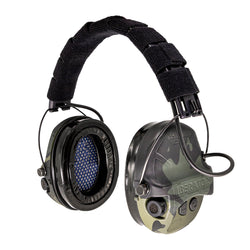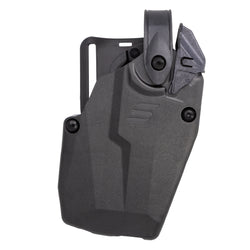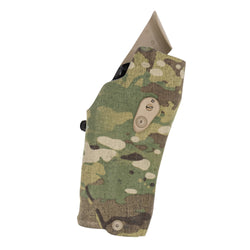Clint Smith was once quoted as saying, “Handguns are not supposed to be comfortable. They are supposed to be comforting.”
As with anything quoted, the interpretation is subjective. One person could take that to mean that you should carry a larger handgun or not carry at all. An optimist might say that a full-sized handgun, although more uncomfortable to carry, is easier to draw and shoot than smaller handguns.
Much ink has been dedicated to the art of concealed carry with duty-sized and compact handguns in mind. While some of us carry a full-sized Glock or 1911, or any number of handguns in that category, the sales numbers indicate that subcompact and pocket-sized handguns are more popular.

That was true in the heyday of the derringer in the Wild West, which far exceeded the number of Colt Peacemakers on the beltline. It is still true today, with snub-nosed revolvers, and subcompact double-stack and single-stack pistols. These handguns are easier to carry every day and even easier to hide with a wider variety of wardrobe setups.
But easier is not the same as easy, and there are tradeoffs to the platform. As such, it is vital to dress around your subcompact handgun, take posture and positional measures to reduce printing, select a comfortable holster, and practice drawing through your clothing layers to get on target quickly and consistently.

Here are some intentional strategies for carrying and deploying subcompact pistols.
Posture Matters
Tangentially related to clothing selection and tied into holster selection is posture. Posture is how our muscles hold our skeletal structures upright. No one person’s posture is the same, as it varies through years of neglect and maintenance and can be affected by everything from spinal curvature to the nature of your occupation.
But the clothes you select and the holster you fit that look great while you stand erect, will be wanting when you settle into your day-to-day life of slouching, bending, and stooping. You may be straight as an arrow in real life, or your posture may be terrible. No matter how you carry yourself, use it to your advantage or pay the price.
After many years of carrying subcompact handguns forward of the hips, I have developed a forward slouch so that previously ill-fitting undergarments will readily cover the pistol and holster. Don’t do that.
Shop for clothes, pistols, and holsters with your natural posture in mind. Try to improve your posture for the sake of your long-term health, but understand that you need gear that will remain hidden and nonprinting on your worst days.
Dress for Success With Subcompact Pistols
As the great economist Thomas Sowell once stated, “There are no solutions, only tradeoffs.” In the case of concealed carry handguns, you trade off some fashion for utility. Duty handguns can be concealed if you dress completely around the gun, although the choice of clothes can make you stick out like a sore thumb.
Subcompact pistols require few changes, but you sacrifice ballistic performance and a clean draw in some scenarios. While you can take more liberties with subcompact handguns that conceal inside or outside the waistband, you should still be wary.

Fit and fabric type still matter. You may buy a cotton T-shirt and find it fits perfectly on the first wear, only to find it too short after one run through the washer/dryer.
Men’s athletic and casual tees tend to be geared toward attraction for the opposite sex. The chest is roomy, but the waist is small, and the arms are tight. But a smaller waist can make the imprint of a handgun underneath that shirt more obvious.
Even looser fitting shirts with lower thread counts like silk and knit material can bunch up at the edges and leave you with little room for movement without exposing the top of the holster. As you layer in the winter months, previously perfect-fit shirts now stretch tight by the undershirt.
With a quality tuckable holster, some of these shirt issues can be remediated as the shirt will tuck in around the handgun without the tail of the shirt being loose to move. But you don’t want to be stuck with a material that is too tight to start, and certainly so when your everyday dress might be more casual and untucked.

Hot Weather Considerations
In warmer weather, subcompact pistols allow some forgiveness in the dress code compared to full-sized handguns. But while colder weather allows for bigger and longer jackets, hot weather can make that chunk of steel and polymer on your side more burdensome.
It is tempting to dress in light colors that print more easily and revert to lightweight, though problematic, cotton tees. The key to warm weather success is proper holster selection (covered below) and selecting a quality undershirt that will serve as a barrier between your skin and your firearm.
Dri-fit shirts are a lightweight and comfortable solution that does not bunch up. But these garments might shrink if dried in high heat or washed in a hot cycle. These synthetic shirts also stink to high heaven once wet.
For summertime carry in the swampy South Louisiana climate, I have gravitated to merino wool. This blend of wool is lightweight and does not have the characteristic scratchiness of traditional wool.
Merino does not stink and maintains its insulation value, even when it is soaked. That makes it excellent for keeping heat in in winter and retaining sweat to cool you in the summer. It is also more dense than other synthetics to serve as a meaningful barrier to keep your side from chafing while carrying.
Colt Weather Layering Tips
In summer, I favor a merino wool undershirt fronted with any generic overshirt. In winter, the same undershirt doubles as a base layer with additional layers under a jacket as needed. But it is worth a word of caution to keep the number of layers between the gun and your potential targets to a minimum so that it will not inhibit the draw stroke.
The Right Holster in the Right Place
Subcompact handguns are prized for their ease of concealment, but ease does not mean effortless.
The wrong holster and the wrong position along the belt line are bad, whether you are carrying a full-sized, compact, or subcompact handgun. This, combined with the wrong clothing and improper posture, can make any handgun obviously visible at the least and painful to carry at worst. The last thing we want is for you to go unarmed when you otherwise might be able to, for a simple equipment modification.
Even before ruling out your wardrobe, finding the right holster and wearing it in the right place can solve concealment headaches—or in this case, body aches.
Inside-the-waistband holsters tend to be more effective at concealment than outside-the-waistband options, as the bottom of the holster and handgun are effectively covered up and the outline of the handgun is broken by the belt line. But depending on the girth of your handgun, IWB holsters will dig into your side or stomach, whereas an OWB option excels in comfort and conceals well with a generous shirt tail.
Appendix, Hip, and Other Carry Positions
Once you have the holster to fit your needs, next comes figuring out where along the belt line to carry. Forward of the hips in an “appendix” position is great for quick 1-second draw scenarios, but can pose potential safety issues, particularly when re-holstering in a dynamic environment. Carrying forward of the hips gets old fast if you spend much of your day stooping and bending, as the pistol digs into the stomach.

Carrying a subcompact pistol on the hip is a tad slower at the draw and can print more with the wrong shirt setup. However, it is a comfortable neutral position. The same is true for just behind the hips at the 4 or 8 o’clock position. This position has the added advantage of better concealment in face-to-face interactions as the pistol is behind you. However, if your occupation involves a lot of sitting, the pistol can be harder to get to.
SOB, or small-of-back carry, provides the slowest draw and poses safety hazards of its own, as the pistol is placed directly against the spinal column.
Select the carry position that balances comfort with the scenarios you are most likely to face.
Practice with Subcompact-Friendly Drills
You can have the best handgun and holster combination, carried in the smartest way, under the most comfortable clothes, but none of that matters if you can’t get to that handgun in time.
Full-sized handguns are favored since their larger size makes them easier to grab, go, and put hits on a target quickly and accurately. Practice makes perfect, whether you are drawing from concealment or going for groups. It is vital for full-sized guns, but even more so with subcompact handguns for concealed carry.

Subcompact pistols have shorter barrels and shorter, smaller grips over their full-sized counterparts. Shorter barrels give off more muzzle flash and blast, and the abbreviated grip can be difficult to get a sure, high grip on in a hurry.
Some subcompact pistols, particularly those that are chopped versions of existing full-sized designs, are also more malfunction-prone. In my own experience, I have had good luck with full-sized 1911 handguns, but the smaller the version, the more feeding and firing issues I encountered. These issues can come down to the mechanics that are lost when going down in size. It can also come down to ammunition differences and user error.
With all this in consideration, it is particularly important to get the draw ironed out. Dry fire practice at home is free, and there are no range rules to follow.

Practice getting that grip without looking and breaking the trigger on a target. It is easy to do standing up, but don’t forget to customize that practice to your day-to-day routine. I do much of my dry fire practice on the coach as the lion’s share of my day is sitting. You would be surprised how good math gets thrown off and how you might have to change the holster arrangement.
Translate dry fire practice to live fire at the range. Some ranges allow drawing from the holster, while some do not. No matter what is available to you, you can still develop the muscle memory to get a good grip and trigger press for subcompact success.
Conclusion
For most of us, subcompact pistols offer a great balance of usefulness, convenience, and comfort to ensure that you can carry every day.
But subcompact pistols come with their own challenges to master. It is even more important to master getting a strong grip on the draw stroke and getting a solid trigger press, where full-sized handguns offer a little more forgiveness.
Furthermore, while subcompact handguns are easier to conceal, it does not mean you can abdicate certain unchanging aspects of a carry lifestyle.
While you do not have to overhaul your entire wardrobe and spend hundreds of dollars on holsters and belts, some care has to be taken. Depending on your posture, some clothes will simply not do and not all clothes are created equal to maximize concealability in all positions.
Holster selection and holster placement are also paramount to ensure rapid, safe access as well as comfort. Ignore considerations like these, and you might just find yourself with a lesser firearm or no firearm at all. Take them to heart and carry confidently.









